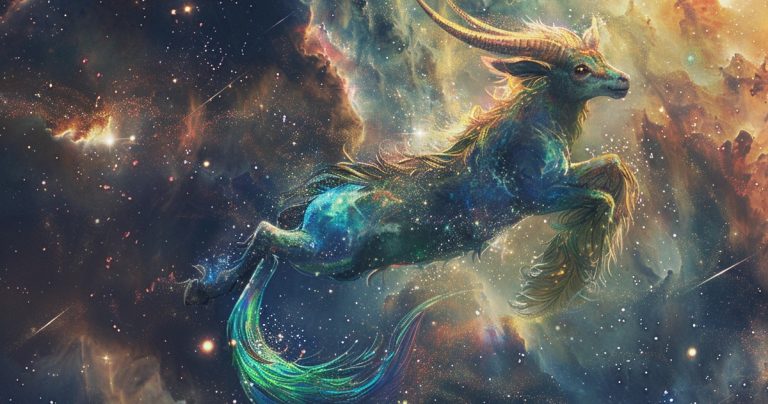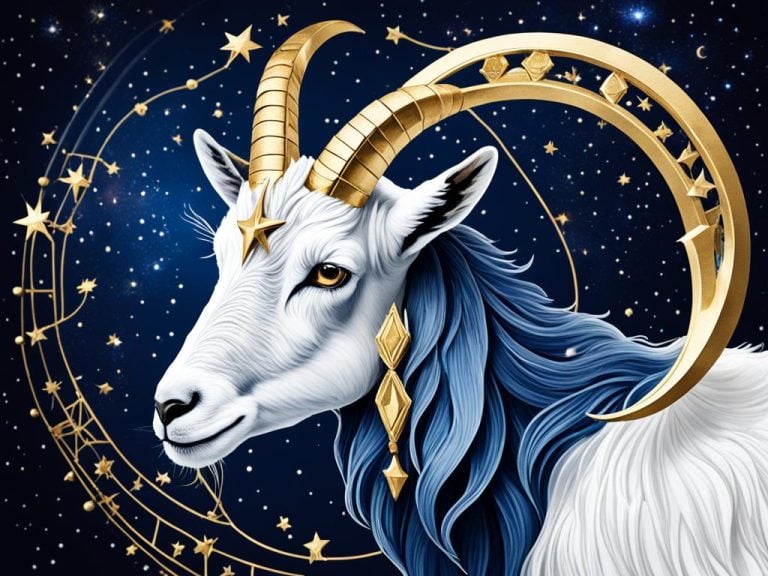Explore the Mysteries of Capricornus Constellation
Modified: July 7, 2024 Author: International Star Registry
Did you know the Capricornus Constellation is called the Sea-Goat? It’s been intriguing people for ages. It’s one of 88 known constellations and sits in the southern sky. Yet, it’s more than just a pretty sight.
Now, in the world of astrology, it represents the Capricorn zodiac sign. People born under Capricorn are known to be driven and focused. But there’s more to learn about this amazing star pattern.
You can see Capricornus best in July and August in the North. Look for stars like Deneb Algedi, Nashira, and Dabih. Its shape and meaning make it interesting for anyone who loves stars.

Key Takeaways:
- The Constellation Capricornus , also known as the Sea-Goat, has captivated human imagination for centuries.
- Capricornus is represented by the sign of Capricorn in astrology, known for its ambitious and disciplined nature.
- Best observed during July and August in the Northern Hemisphere, Capricornus features notable stars like Deneb Algedi, Nashira, and Dabih.
The History and Mythology of Capricornus Constellation
The “horned goat” or Capricornus constellation has an ancient history and legends. Like tales of gods and creatures, these stories have captivated people for ages.
Mesopotamian myths tell us about the wise and fertile god Enki. He was linked to this constellation, maybe because it appeared with the rains. This ties it to the life-giving force of water in those times.
In Greek tales, Capricornus is bound to Pan, a god who fled a monster. To escape, Pan turned into a sea-goat, marking the path for spirits of the dead. This symbolizes a doorway between life and what comes after.
Across the world, stories show Capricornus as a mix of a goat and fish. There are images from Babylon over 5,000 years ago. They show the sea-goat, highlighting its lasting impact.
Indian and Chinese sky watchers link Capricornus with their own stories. India calls it Makara, meaning “crocodile,” and in China, it’s part of a sacred area.
Looking to learn more about these myths? Visit the Constellation Guide or Wikipedia.
Capricornus is loved not just for its stories but also its place in the sky. It’s big, ranking 40th in size, and hosts five stars known for having planets. The brightest, Deneb Algedi, shines at 2.81 apparent magnitude.
It neighbors Aquarius, Aquila, and more, showcasing sights like Messier 30 and NGC 6907. These include a cluster and a galaxy.
Capricornus’s tales give it charm and meaning. Its name means “goat” in Latin, reflecting its look. It’s an adventure to dive into the stories of this celestial marvel.
The Significance of Capricornus in Astrology
Capricornus is part of the twelve zodiac constellations and is very important in astrology. It represents those born as Capricorns, and they are seen as ambitious, disciplined, and determined. They work hard and have a strong focus on their goals.
Capricorns are known for their practical and detail-oriented nature too. They are seen as leaders because of their consistent approach. Their ability to take control makes them reliable in any situation.
The symbol of Capricornus highlights its link to the element of Earth. This stands for stability and a strong connection to reality. This influences Capricorns towards their practical and achievement-driven lives.
For those born under Capricorn, knowing about Capricornus in astrology is helpful. It gives insights into their strengths and challenges. This understanding can guide them to a successful life path.
Capricornus and the Other Zodiac Signs
Each zodiac sign has its unique qualities and elements. Capricorn interacts differently with others, affecting their relationships and compatibility.
- Aries (March 21 – April 19): Capricorn and Aries might have different life views, but their shared goals create a good balance.
- Taurus (April 20 – May 20): Capricorn and Taurus relate well as they share the Earth element. This bond supports their mutual practicality and stability.
- Gemini (May 21 – June 20): Capricorn’s organized style meets Gemini’s adaptability. Their partnership can lead to personal growth and learning.
- Cancer (June 21 – July 22): Capricorn’s stable nature combines well with Cancer’s caring side, forming a strong and supportive relationship.
Understanding how Capricorn interacts with other signs helps in managing all relationships better, both at home and at work.
The Symbolism of Capricornus
Capricornus is the Sea-Goat, blending earth and water features. It combines a fish’s lower body and a goat’s upper body. This mix shows the balance between being practical and setting high goals. The Sea-Goat stands out in the night sky because of this.
Capricornus’ meaning comes from ancient times. The Sumerians and Babylonians called it Suhur-Mash-Ha, the “Goat-Fish.” Ptolemy cataloged it among the 48 constellations. It also has a role in astrology, symbolizing leadership and ambition.
This constellation marks the seasons changing. For those in the north, it’s a fall constellation. It marks the winter solstice, which is around December 22nd to January 19th. Please note the solstice has moved to Sagittarius over time.
While not having many bright stars, Capricornus has some special ones. Deneb Algedi is its brightest with a magnitude of 2.9. Nashira or Gamma Capricorni is a white star 100 light-years away.
Capricornus includes a barred spiral galaxy and a globular cluster for amateur star gazers. It also has five meteor showers. These include the Alpha Capricornids and the Capricorniden-Sagittarids.
If you want to learn more about Capricornus, check out this link. For a deep dive, there’s this academic article waiting for you.

The Star Map of Capricornus Constellation
Capricornus sits between Sagittarius and Aquarius. It’s close to the Sun’s path, making it important in astrology.
The map of Capricornus shows many stars. Each star shines brightly, adding to the constellation’s beauty. Stars like Deneb Algedi bring their charm to the sky.
Learning about Capricornus is amazing. This constellation’s history is rich in myths. It has fascinated people for centuries.
Discover the Celestial Beauty
The map shows a beautiful figure in the sky. It’s made of sparkly stars. This view is breathtaking.
Imagine ancient uses of the stars as you look at the map. People told stories and found their way using these stars. It shows humans and the universe are connected.
The map is for anyone who loves astrology, myths, or the stars. With the Capricornus map, you can start an amazing journey in the stars.
Buy a Star in Capricornus as a Unique Gift
Want a special gift for a big moment or to remember someone you love? Buy a star for someone in Capricornus. It shows how much they mean to you.
International Star Registry lets you name a star after someone easily. Just go to their website, starregistry.com, and you can pick the right star in Capricornus. It’s a simple way to make a gift that lasts forever.
When you name a star, you get a pretty certificate. It has the star’s name and where it is in the sky. This certificate is a sweet reminder of your connection with the person you give it to.
Imagine their face lighting up when they see their own star. It’s a gift that will always remind them of you. Their happiness is sure to be beyond words.
Buying a star is great for birthdays, weddings, or any big day. It’s easy and trustworthy with International Star Registry. Make a memory that shines in Capricornus.
International Star Registry and Naming a Star
Looking for a unique gift? How about naming a star in the Capricornus constellation? International Star Registry lets you make a lasting memory with the stars. You can buy a star in Capricornus for someone special.
Naming a star is easy with International Star Registry’s website. Just pick a constellation and enter the recipient’s name. You’ll have a star officially named in their honor. It’s a magical and symbolic gift from you to them.
Why Choose International Star Registry?
- Official Certificate: You get an official certificate when you name a star after someone. It’s proof that the star is really named after the person you choose.
- Unique Gift: A star in Capricornus is a gift like no other. It connects the recipient with the stars, offering a special memory.
- Easy Process: It’s simple to name a star on their website. In just a few steps, you can personalize your gift. And you’ll get the certificate quickly.
Naming a star is perfect for any special time, like a birthday or anniversary. It shows your love and respect. Plus, it gives your loved one a star in the sky they can call their own.

The Celebrities of Capricornus Constellation
This constellation is a favorite among celebrities. Some celebrities that have their very own stars named in Capricornus include Ricky Van Shelton, Crystal Gayle, Juan Antonio, and Nicola Peltz.
This constellation is one of 88 and covers about 414 square degrees. It’s home to stars like Deneb Algedi, Nashira, and Dabih. These stars are bright and important, making Capricornus even more captivating.
Love stars and want to own a piece of the sky? Check out starregistry.com. There, you can buy a star in Capricornus. It’s a unique gift for special moments or to honor someone special.
Capricornus is the 40th biggest constellation. It’s among the smallest zodiac signs in the Southern Sky. Look for it in July and August, especially near Sagittarius. This makes it truly mystical.
When viewing Capricornus, imagine the amazing stories it holds. The Greeks linked it to their god Pan. They called it “goat-horned” because of a story about Pan and Typhon. This is why Capricornus is seen as the “Sea Goat.”
Capricornus’ image is on ancient stones and tablets from the Babylonians, dated back to 16th–12th centuries BCE. The Sumerians knew it as “Goat Fish.” Its role in different cultures shows its lasting appeal and importance.
Do you love space or myths? Exploring Capricornus is a great chance to learn and dream. Take a moment to look at the stars. Let their magic draw you into the amazing Capricornus constellation.
The Astronomical Dates of Capricornus
If you love looking at the night sky, mark your calendar for Capricornus. This small constellation is very special, giving stargazers lots to enjoy.
The sun moves through Capricornus from mid-January to mid-February each year. It’s best seen from the Southern Hemisphere. This gives us a great view of its beauty.
Capricornus has one main deep-sky object, M30. This is a globular cluster about 27,000 light-years away. It looks amazing through telescopes.
The brightest star in Capricornus is Delta Capricorni. It shines at a magnitude of 2.8 and sits about 39 light-years from us. This makes the constellation even more special.
Capricorn is a zodiac sign, but its constellation is unique. It’s linked with those born between December 22 and January 19. This makes it cool to see in the sky.
Capricornus is an ancient constellation. It has been known since the 21st century BCE. People have been curious about it for thousands of years.
Even though Capricornus is not full of bright stars, it’s still interesting. There are more stars and objects to see. This makes it a good spot for astronomers and fans.
Want to learn more about Capricornus? Check out these links for great info: EarthSky, Universe Today, and Go Astronomy.
Conclusion
Capricornus is a constellation with a long history and a lot of meaning. It stands out because of its stories and its place in the sky. You can explore what it means in astrology and even name a star in it.
This makes naming a star in Capricornus a great idea for a special gift. International Star Registry lets you make your mark in the sky. Whether it’s to remember someone, a special moment, or just your love for the stars, you can do it. Check out starregistry.com to get started and shine your light.
FAQ
What is the Capricornus Constellation?
The Capricornus Constellation is known as the Sea-Goat. It’s in the southern sky and one of 88 constellations.
What is the significance of Capricornus in astrology?
Capricornus is big in astrology. It stands for the Capricorn zodiac sign. People born under Capricorn are said to be hard-working and goal-driven.
Where can I find a Capricornus star map ?
To get a detailed star map of Capricornus, check out astronomy websites. They have maps showing its unique pattern of stars.
Can I buy a star in Capricornus as a gift?
Yes, you can! It makes a special gift. International Star Registry lets you name a star in Capricornus. It’s a great way to remember special moments or honor someone dear.
Are there any celebrities associated with Capricornus?
Indeed, there are famous people with stars in Capricornus. Celebrities like Ricky van Shelton, Crystal Gayle, Juan Antonio, and Nicola Peltz have stars there.
When can Capricornus be observed in the night sky?
You can see Capricornus from January 20 to February 16. This period is perfect for those who love stars and astrology. It’s a chance to see the beauty of Capricornus up in the sky.
Source Links
- Explore the Mysteries of Capricornus Constellation with this Zodiac Greeting Card – https://www.pinterest.com/pin/588142032581487169/
- Explore the Mysteries of Capricornus Constellation with this Zodiac Greeting Card – https://www.pinterest.com/pin/explore-the-mysteries-of-capricornus-constellation-with-this-zodiac-greeting-card–611715561906665879/
